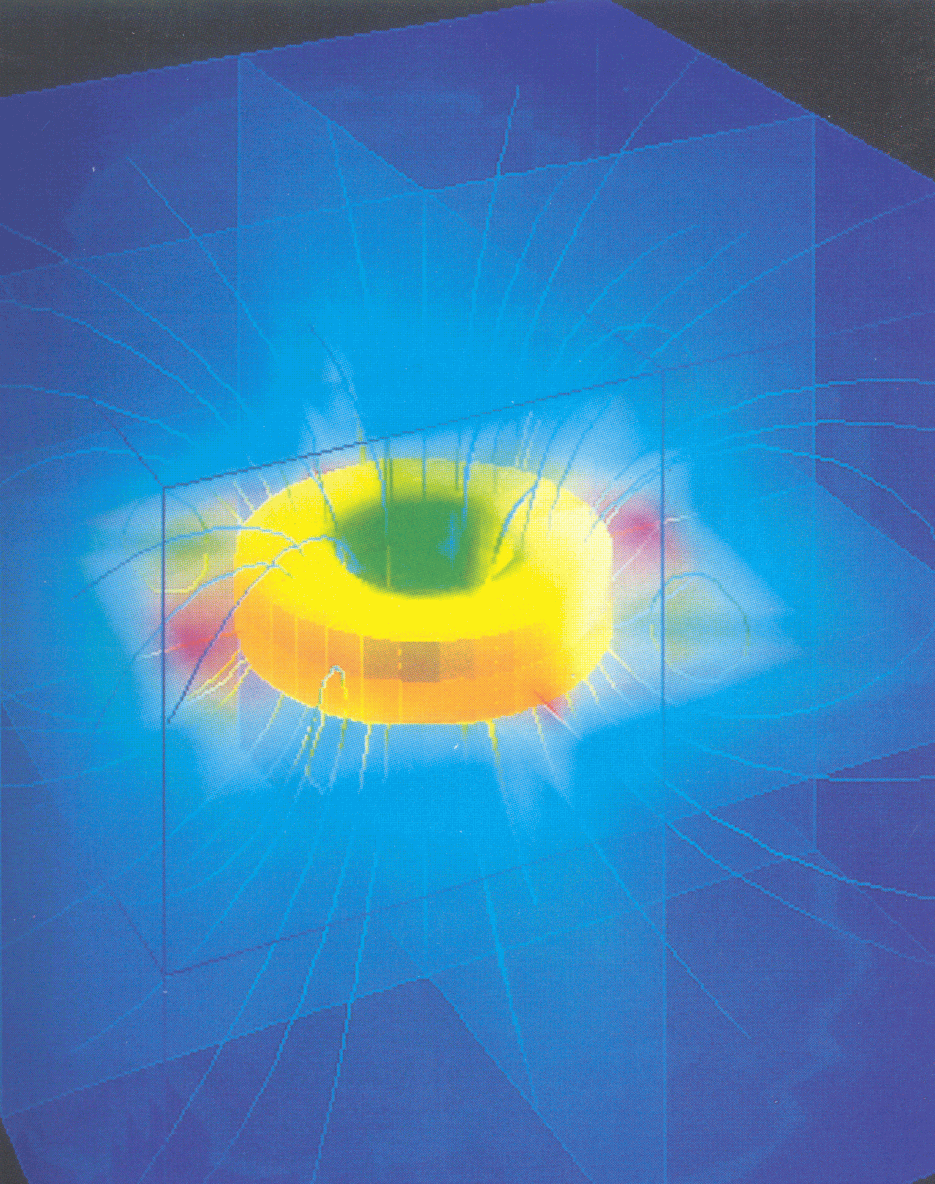

Since the foundation of the Computational Fluid Dynamics Community Club (CFDCC), under the Engineering Applications IT Support Programme (EASE), its membership has steadily grown.
The objectives of the Club are to provide a forum in which to present and discuss research interests of the CFD community, to increase awareness in the community of advanced computing techniques, to propose new activities, and to promote the exchange of CFD software and data.
A major step in the process of encouraging the exchange of software and results has been the organisation of a CFDCC chapter in the public Higher Education National Software Archive (HENSA) at the University of Kent. Through its technical programme the Club has collected a large catalogue of experimental and numerical data and placed it on HENSA as a community resource. In addition to the catalogue, RAL has secured for the community the right to distribute the data from a series of seminars on experimental and numerical validation organised by Stanford University (USA).
A second strand to the CFDCC chapter in HENSA is the Club's Common Software Library. After requesting offers from the community for software to be included in the library, three initial programs have been selected. These are being subjected to quality assurance tests, documented and tested on a number of computing systems. The first of these to be placed on the archive at Kent has been the TEAM software from UMIST.
Four major CFD-related seminars and workshops have taken place this year. Through these meetings the Club has developed its collaboration with others including the Defence Research Agency Advisory Group on Computational Fluid Mechanics (AGCFM) and the Institution of Mechanical Engineers.
Data Visualisation techniques are increasingly being applied to engineering problems to provide the investigator with tools and methods to explore complex or large datasets.
The EASE Programme started a Visualisation Community Club in July 1991. Anyone interested in the interchange of information on visualisation is welcome to register as a member with the Club's coordinator at RAL. Particular achievements during the year have been the publication of two books resulting from a Visualisation Workshop.
As in science, the visualisation problems that occur in engineering are often in 3 dimensions or more; are complex; give rise to large datasets; and may involve data from experimental sources or from simulations. Engineering computation places much emphasis on the study of vector data, of which flow data and electromagnetic fields are prime examples, and on the use of unstructured grids.
In the example shown in Fig 2.1, a previous 3D calculation has determined the field strength of a toroidal magnet. The result of this is a real and imaginary field vector at each node point of a 3D unstructured grid. One of these components is represented in the picture. Using arrows to display the vectors would be straightforward but it is hard to avoid a confusing picture. This picture shows the directional data as streamlines (at any point of which the field vector is tangential) in sufficient detail that confidence can be placed in what is seen.

The investigator chooses how many streamlines are shown and where they start. However, we also want to know the magnitude of the vectors in 3D space. This has been done by using colour - blue is low, red is high. It is also shown on the orthogonal planes passing through the magnet. The planes are drawn partially transparent so that an impression of those parts lying to the rear is also seen.
The picture was generated using the AVS visualisation software, which is now available under a deal negotiated by CHEST.
Energy efficiency and conservation is one of the world's major concerns. Given that buildings are the largest consumers of energy (more than 55% of the UK energy requirements), it is vital that their thermal performance is well understood and optimized. One tool available to building designers and managers is simulation. As the available simulation tools became more rigorous, however, it became important to address the mechanisms by which such systems can be built efficiently and adapted in response to new theoretical advances, changing user needs, deficiencies exposed through use, and changes in the underlying technology. This is the domain of the Energy Kernel System (EKS).
EKS provides a model construction and maintenance platform which almost dispenses with the need to work with source code. EKS will improve researcher productivity and enable researchers, developers and users to evolve future IT products. In the longer term, practitioners will be able to use EKS to create specific tools to handle particular design problems.
EKS is an object-oriented software environment containing a set of class definitions corresponding to the building and thermodynamic domains. These classes provide a set of basic building blocks from which a wide range of modelling programs may be built - from simplified calculators to state-of-the-art simulators. The user, who would be a model builder or energy simulation researcher, constructs a template which defines the structure of some proposed model by selecting the appropriate class (and variant) from those available. EKS regulates the selection of these classes to ensure the resulting template is complete and valid. This template is thus a machine independent high level description of the program structure, and can be stored, communicated and interrogated as wished. In particular, the data model required by the program can be automatically generated and used by third party systems to produce appropriate datasets for the program. The template is then processed, in conjunction with the specific dataset, into an executable program tailored specifically to the supplied dataset.
EKS now exists as a demonstrator (Fig 2.2) and is being evaluated by several groups in the building simulation research community. Most of the techniques employed and much of the underlying code will be directly relevant to other engineering disciplines.

In the recently completed GATEWAY project, RAL's Knowledge Engineering Group has been developing metrics for knowledge based systems. The project was collaborative with Logica Cambridge Ltd and Integral Solutions Ltd under the JFIT Programme.
This two-year project addressed some of the main issues in software project management, such as cost estimation, benefit analysis, risk assessment, and quality assurance. The approach is to accommodate qualitative and quantitative measures. Many of the metrics rely on the assessment of parameters whose values are on ordinal scales.
The key is the Project Model which allows measurable attributes to be placed within a coherent information repository. Much of this framework has also been implemented as a prototype project information gathering tool by one of the partners.
The Cost Model maps knowledge about the application domain, the development team, the organizational environment and other indicators onto quantitative bands for required effort. The Benefit Model assists in establishing a business case, and in assessing the feasibility of a project: for example, are the benefits tangible or intangible, short-term or long-term, will they be savings in resources or open up new markets? The Risk Model deals with technological risks, as well as external risks. Its major purpose is to make managers aware of high risk items and, possibly, to assign a risk vector to a project. Another way of using the risk model is to guide the project manager in alleviating some risks, and checking later on whether these actions have actually resulted in a lower risk.
The Quality Model can be used to look at issues such as usability, maintainability, and performance. Comparing the actuals with the required values enables users to monitor the level of quality achieved.
The main result is a handbook for practical use which describes the metrics models and their modes of use and presents the metrics in tabular formats.
The SERC/DTI Transputer Initiative (1987-1992) was designed to introduce the new parallel technology rapidly both to industry and academia.
The single most substantial service provided to academics was an equipment loan pool containing representative examples of commercially available transputer hardware and software. In total the Pool supplied 165 loans lasting between 4 and 12 months.
An independent review found that this was an extremely popular and cost-effective service and identified the average equipment cost per loan as just £2900. Researchers, many with no previous transputer experience, were able to develop their ideas quickly and, in 67% or more of cases, submitted grant applications (mostly to SERC or the EC), purchased equipment, and published papers. The objective to improve the quality of research involving transputers and parallel processing has been demonstrated. Table 1 shows the results from a survey of loan beneficiaries.
QUESTION Yes% No% ?% Are you still using transputers? 88 12 0 Was the loan beneficial to your research project? 96 4 0 Did the loan lead to a transputer based on grant application? 67 33 0 Did the loan lead to an equipment purchase? 78 16 6 Did the loan lead to any publications or conference papers? 67 4 29
All suitable loan applications (75% of the total of 220 submitted) were satisfied, the majority within three months of submission. Popular areas were numerical analysis, signal processing, tools and theories, simulation, graphics, and image processing. A total of 105 loans resulted in reports made widely available through the Initiative; 56 also generated software for a library operated first by the Initiative's Transputer Centre at Sheffield and later by that at Liverpool, accounting for more than 50% of the library software. The review analysed the 71 final reports received and rated these in five grades shown in Table 2.
Grade Number
Achieving
Grade Interpretation of Grade %
5 10 Speed-ups demonstrated AND publication of results 14
4 21 Speed-ups demonstrated OR publication of results 30
3 27 Promising single transputer or theory results 38
2 7 Familiarisation with transputer technology 10
1 6 Poor attempt to exploit loan 8